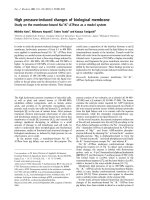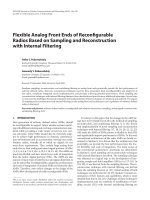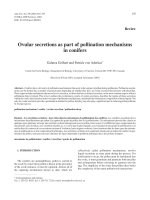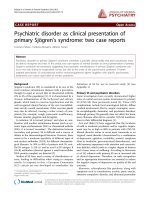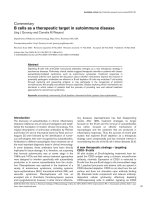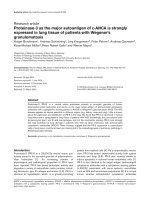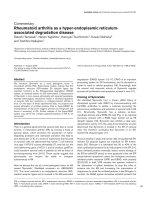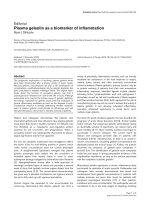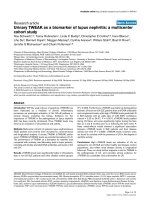Báo cáo y học: " Cyanide intoxication as part of smoke inhalation a review on diagnosis and treatment from the emergency perspective" pps
Bạn đang xem bản rút gọn của tài liệu. Xem và tải ngay bản đầy đủ của tài liệu tại đây (248 KB, 5 trang )
REVIEW Open Access
Cyanide intoxication as part of smoke inhalation -
a review on diagnosis and treatment from the
emergency perspective
Pia Lawson-Smith
1*
, Erik C Jansen
2
, Ole Hyldegaard
1,2
Abstract
This paper reviews the current literature on smoke inhalation injuries with special attention to the effects of
hydrogen cyanide. It is assumed that cyanide poisoning is still an overlooked diagnosis in fire victims. Treatment
against cyanide poisoning in the emergency setting should be given based on the clinical diagnosis only. Oxygen
in combination with a recommended antidote should be given immediately, the first to reduce cellular hypoxia
and the second to eliminate cyanide. A specific antidote is hydroxycobalamin, which can be given iv. and has few
side effects.
The most common occurrence of cyanide
poisoning
Several reports have shown that persons admitted to
hospital due to fire accidents may have been exposed to
carbon monoxide (CO) as well as cyanide (CN) [1-3]. In
fact , it has been reported that the most common source
of CN poisoning in humans arise from exposure to fires
[4]. In fires CN is developed when the temperature
reaches 315°C (600°F) and is released from the toxic
fumes in the gaseous form, i.e. hydrogen cyanide (HCN)
which may then be inhaled by the victim [1]. HCN is
developed from an incomplete combustion of any mate-
rial containing nitrogen [5] such as plastic, viny l, wool
or silk [6]. It is worth noticing that when cotton burns
it develops 130 μg HCN/g, paper 1100 μgHCN/gand
wool 6300 μg HCN/g. One has to be aware that HCN is
still produced when the fire is only glowing embers [7].
Symptoms of cyanide poisoning
HCN is easily absorbed from all routes of exposure [8].
Since CN is a small lipid soluble molecule and mainly
undissociated, distribution and penetration of CN into
cells is rapid. CN can be distributed in the body within
seconds and death can occur within seconds or m inutes
after a large dose [9,10]. Initially, the symptoms include
a brief peri od of hyperpnoea, due to direct stimulation
of the chemo receptors of the carotid and aort ic bodies
by CN [11]. CN also stimulates the nociceptors, leading
to a brief sensation of dryness and burning in the nose
and throat [12]. In milder cases of CN poisoning the
symptoms are headache, nausea, vertigo, anxiety, altered
mental status, tachypnea, hypertension and there may
be an odour of bitter almonds in the patients expiration.
In more severe cases the patient will have dyspnoea, bra-
dycardia, hypotension and arrhythmia. In most severe
cases the patients symptoms are unconsciousness,
convulsions, cardiovascular collapse followed by shock,
pulmonary oedema and death [6]. Death is due to
respiratory arrest but the heart invariably outlasts
respiration and may continue to beat fo r as long as
3-4 min. after the last gasp [8,12].
Virtually a ll patients with severe, acute CN poisoning
die immediately. Autopsy findings include petechial,
subarachnoid or subdural haemorrhages [13]. As very
few people survive severe CN poisoning, reports of late
neurological sequelae are rare.
CN poisoning in mild degrees is recognized as a cause
of permanent neurol ogical disability, ranging from var-
ious extrapyramidal syn dromes to post-anoxic vegetative
states [14]. Most cases develop over many years. Both
parkinsonian symptoms and a dystonia syndrome have
been observed [15-18].
* Correspondence:
1
Laboratory of Hyperbaric Medicine, Department of Anesthesia, Center of
Head and Orthopaedics, University Hospital Rigshospitalet, Blegdamsvej,
Copenhagen, 2100, Denmark
Full list of author information is available at the end of the article
Lawson-Smith et al. Scandinavian Journal of Trauma, Resuscitation and Emergency Medicine 2011, 19:14
/>© 2011 Lawson-Smith et al; licensee BioMed Central Ltd. This is an Open Access article distributed under the terms of the Creative
Commons Attribution License (http://creativecommons. org/licenses/by/2.0), which permits unrestricted use, distribution, and
reproduction in any medium, provided the original w ork is properly cited.
Mechanism of toxicity of CN
The similarity between CO and CN is the ability to bind
iron ions. However, where CO impairs the ability of ery-
throcytes to transf er oxygen, CN binds to erythrocytes
but does not affect the oxygen transfer. Both CO and
CN affect the mitochondria by b inding to the enzyme
cytochrome-c oxidase a, a3 (CCO), the terminal enzyme
complex of the respiratory chain in complex IV [10].
Theactive(O
2
-binding) site of CCO is binuclear, con-
sisting of heme a
3
and Cu
B
[19]. CO binds to the
reducedformofCCOandCNbindstoeitherthe
reduced CCO heme (Fe
2+
)oroxidizedheme(Cu
B
2+
)
[20-22]. The primary effect of CN is a blocking of the
mitochondrial respiration chain and the formation of
intracellular adenosine triphosphate (ATP) [ 10]. The
result is cytotoxic hypoxia caused by t he inhibition of
CCO by the high affinity of CN to heme a
3
of the
enzyme. The effect is a structural change and a reduced
activity of the enzyme and an increase in lactate produc-
tion resulting in metabolic acidosis [23,24].
Diagnosis
CN poisoning seems to be an overlooked diagnosis in fire
victims. In 1991, Baud showed that persons from fi re
accidents were poisoned by both CN and CO [25]. The
diagnosis of CN poisoning presents a dilemma for first-
response emergency personnel. Clinicians are often able
to diagnose CO poisoning by either arterial- or venous
blood sampling measuring carboxyhaemoglobin or by
oximetry although the latter may be unreliable [26].
Diagnosing CN poisoning however, remains a challenge
in the emergency setting. At the same time immediate
treatment is of outmost importance. Given the fact that
methods to detect and measure CN in blood are usually
not readily available and that patients may often be
exposed to both CO and CN, clinicians have to rely on
the presenting symptoms and the general clinical status
of the patient. In patients hospitalised with a history of
fire accident, combined with severe neurological symp-
toms such as reduced Glasgow Coma Scale (GCS) Scor-
ing and either soot particles in the mouth or trache al
expectoration, is likely to be an indicator of concomitant
CN poisoning [23]. Baud et al. found that the concentra-
tion of lactate increases proportionally with the amount
of CN poisoning because of the metabolic acidosis [27].
Based on these observations and given the fact that
whole blood CN measurements may not be available,
the patient admitted to hospital after exposure to fire
combined with smoke inhalation injuries, supplementary
CN intoxication should be suspected if two or more of
the following criteria are fulfilled:
1) Signs of neurological incapacitation suc h as altered
mental status, unconsciousness and convulsions
2) Soot in the mouth or expectoration
3) Fire accident patents where arterial blood sampling
reveal metabolic acidosis with a lactate above 8 mmol/l
as the concentration of lactate increases proportional
with the rate of CN poisoning. A lactate of 10 mmol/l is
a sensitive and specific indicator of CN intoxication [23].
Currently, two methods of whole blood CN analysis
dominates the literature:
One method is the Conway/microdiffusion method
where test mate rial is whole blood. CN is liberated from
the blood into the gas phase and subsequen tly bound to
hydroxycobalamin (OHCob) forming c yanocobalamin
(CNCob). The concentration of CNCob can be read my
means of a spectrophotometer [28]. Results are available
within a 2-h period.
The other method is isotope-dilution gas chromato-
graphy-mass spectrometry (ID GC/MS) that is an auto-
mated procedure where test material is whole blood.
Samples are prepared and analysed within a 2-h period
[29].
With the current available methods for the analysis of
CN blood concentrations, one may co nclude that in the
clinical setting it takes hours before a result may be
available for the treating doctor [30]. Furthermore, CN
is an unstable molecule and has an elimination half-life
of 1 hour in blood in vivo. Therefore determination of
CN in blood requires rapid sampling and analysis
[25,27].
Treatment
The treatment of CN poisoning is aiming at basic life
support including 100% oxygen, assisted ventilation if
the patient is unconscious (GCS < 8) or the airway
seems compromised, decontamination, correction of
acidosis and blood pressure support [31,32] combined
with the use of an antidote. Currently there are four
types o f antidotes. These include OHCob, sodium thio-
sulfate, dicobalt edetate and methaemoglobin forming
antidotes. Initial evaluati on of antidotal efficacy is based
on correction of hypotension and lactic acidosis and the
final outcome rests on the degree of permanent central
nervous system injury [33]. The different antidot es shall
be described briefly here below.
OHCob has a rapid onset of action as it dissolves into
the different tissue compartments almost immediately
when administered by infusion [34]. It has the advantage
of not interfering with tissue oxygenation [35] and in
both human and animal studies it has been shown to
improve hemodynamic stability [34,36-38]. OHCob acts
by covalent binding to CN and forms cyanocobalamin
(CNCob) which is B12 vitamin [39,40]. CNCob is
excreted through the kidneys [41]. Given iv. OHCob dis-
tributes to the erythrocytes and plasma cells and after
Lawson-Smith et al. Scandinavian Journal of Trauma, Resuscitation and Emergency Medicine 2011, 19:14
/>Page 2 of 5
30 minutes it reaches the cerebrospinal fluid [42]. Side
effects are red colouring of skin and urine, urticarial
eczema and seldom anaphylactic chock [32]. In a series
of normal human volunteers given 5 g of OHCob iv.
during 20 minutes, a mild, transient, self-limiting hyper-
tension accompanied by reflex bradycardia has been
reported [38]. OHCob must not d elay any other basic
life support such as securing of the airways, cardiovascu-
lar support or oxygen supply [31,32]. OHCob in blood
interferes with CO-oximetry measurements of COHb,
methemoglobin (MetHb), and Hb-O
2
.Thismustbe
considered during OHCob treatment, particularly in
smoke inhalation victims with concurrent CO exposure,
because it may lead to potentially erroneous reported
COHb levels. OHCob will cause an increase in mea-
sured COHb percentage values [43].
Sodium t hiosulfate removes CN from the blood
through the action of rhodanese [44]. Rhodanese is an
enzyme located in the mitochondria mainly in the liver,
kidney and skeletal muscles [45,46]. It adds a sulphur
atom to CN and forms thiocyanate which is less toxic
and excreted through the kid neys [47,48]. Sodium thio-
sulfate has limited distribution into the brain as well as
limited penetration into the mitochondria, where the
endogenous rhodanese is located [40,49]; accordingly
sodium thiosulfate exerts its main effect in blood and
plasma [50]. Sodium thiosulfate has a slow onset of
action [6]. Less significant side effects such as nausea,
vomiting, and injection site pain, irritation, and a burn-
ing sensation has been reported [39,51]. There is limited
information available about the efficacy of sodium thio-
sulfate for treatment of CN poisoning [35]. No clinical
trials of sodium thiosulfate are available, and efficacy
has been extrapolated from case s tudies and series of
acute CN poisoning.
Dicobalt EDTA is an efficient antidote with a high
affinity to CN but it has restricted use. The mechanism
of action is chelation of CN to form the much less toxic
cobalt cyanide. Dicobalt EDTA has delet erious cardio-
vascular side effects and is often poorly tolerated. To
mitigate these side effects intravenous glucose should be
co administered during treatment. The side effects are
enhanced if the patient is not CN poisoned so it should
be used only in very severe cases where the diagnosis is
certain [32,35,40].
Amyl nitrite and sodium nitrite are methemoglobin
forming antidotes, which are relatively contraindicated
in smoke inhalation. Nitri te reduces blood CN by form-
ing methemoglobin, to which CN binds with higher affi-
nity than it does to CCO. Significant side effects such as
vasodilatation and hypotension are seen during treat-
ment. Induction of methemoglobin forming antidote
treatment has the potential to impair the oxygen carry-
ing capacity of haemoglobin [6]. In the smoke inhalation
victim, with concomitant COHgb increase and possible
pulmonary injury, there is an obvious added risk asso-
ciated with methemoglobin formation [6].
Adjunctive treatment of CN intoxication
Hyperbaric oxygen therapy (HBO) is recommended by
UHMS as an adjunct to the treatment of CO poisoning
complicated by CN poisoning [52]. HBO has been
shown to improve survival and improve tissue oxygena-
tion in the clinical as well as in the experimental set-
tings [53] and HBO is recommended especially when
supportive measures and other CN antidotes fail
[54-56]. Several studies have demonstrated a protective
effect of HBO t herapy in experimental ischemic brain
injury, and many physiological and molecular mechan-
isms of HBO therapy-r elated neuroprotection have been
identifi ed [57]. Also HBO has been shown to reduce the
risk of cognitive sequelae after acute CO poisoning
when HBO is giv en within a 24-hour period [ 58].
Furthermore it has been shown that HBO increases the
flexibility of red blood cells (thereby improving micro-
circulatory perfusion), reduces tissue oedema and pre-
serves intracellular ATP [59-62]. The binding of CN to
CCO is most often referred to as being irreversible
[23,32]. However, recent evidence suggests that CN
binding to CCO is reversible. Where CN binding to
CCO appears to be independent of the oxyge n tension,
there seems to be a competition between CN and nitric
oxide (
•
NO). High concentrations of
•
NO have been
found to attenuate the inhibition of CCO induced by
CN and CO [63,64 ]. In keeping with this, HBO therapy,
but not no rmobaric oxygen, has been shown to increase
the bioavailability of
•
NO [65-69] which may show to be
beneficial during CN poisoning. Whether HBO therapy
hol ds any place in the treatment of acute CN poisoning
when readily available is a matter of continued debate.
In keeping with the above and the fact that patients
from fires are both CO and CN poisoned we recom-
mend HBO as well where safely available.
Conclusion
Treatment of suspected CN poiso ning presents a
dilemma for medical first-response emergency person-
nel, as clinicians are often unable to diagnose CN poi-
soning in the emergency setting. Immediate treatment is
of outmost importance. In summary immediate treat-
ment includes 100% oxygen, assisted ventilation if the
patient is unconscious (GCS < 8) or the airway seems
compromised, decontamination, correction of acidosis
and blood pressure support [31,32]. Antidotes include
OHCob, sodium thiosulfate, di-cobalt EDTA and
methaemoglobin-inducers. Currently, there is no inter-
national agreement of which antidote is the preferred to
use but OHCob and sodium thiosulfate seem to be
Lawson-Smith et al. Scandinavian Journal of Trauma, Resuscitation and Emergency Medicine 2011, 19:14
/>Page 3 of 5
among the most widely accepted antidotes. OHCob i s
an attractive antidote due to its rapid CN binding and
its lack of serious side ef fects, even in the absence of
CN intoxication. Accordingly this is the recommended
antidote treatment in Denmark to known or suspected
CN poisoning. In France OHCob is given prehospital by
EMS personnel but not in Denmark, as the Health Min-
istry has not approved it for this use [70].
Author details
1
Laboratory of Hyperbaric Medicine, Department of Anesthesia, Center of
Head and Orthopaedics, University Hospital Rigshospitalet, Blegdamsvej,
Copenhagen, 2100, Denmark.
2
Hyperbaric Unit, Department of Anesthesia,
Center of Head and Orthopaedics, University Hospital Rigshospitalet,
Copenhagen, 2100 Denmark.
Authors’ contributions
PL-S drafted the manuscript. All authors read and approved the final
manuscript.
Competing interests
The authors declare that they have no competing interests.
Received: 1 March 2010 Accepted: 3 March 2011
Published: 3 March 2011
References
1. Alarie Y: Toxicity of fire smoke. Crit Rev Toxicol 2002, 32:259-289.
2. Eckstein M, Maniscalco PM: Focus on smoke inhalation–the most
common cause of acute cyanide poisoning. Prehosp Disaster Med 2006,
21:s49-s55.
3. Jones J, McMullen MJ, Dougherty J: Toxic smoke inhalation: cyanide
poisoning in fire victims. Am J Emerg Med 1987, 5:317-321.
4. Walsh DW, Eckstein M: Hydrogen cyanide in fire smoke: an
underappreciated threat. Emerg Med Serv 2004, 33:160-163.
5. Walsh DW, Eckstein M: Hydrogen cyanide in fire smoke: an
underappreciated threat. Emerg Med Serv 2004, 33:160-163.
6. Gracia R, Shepherd G: Cyanide poisoning and its treatment.
Pharmacotherapy 2004, 24:1358-1365.
7. Montgommery , et al: Comments on fire toxicity. 2008, 179-212, Comb.
Tox.2.
8. Snodgrass WR: Clinical Toxicology. In Casarett and Doull’ s Toxicology - The
basic science of poisons. Edited by: Klaassen CD, Amdur MO, Doull J. New
York: McGraw-Hill; 1996:969-986.
9. Borowitz JL, Rathinavelu A, Kanthasamy A, Wilsbacher J, Isom GE:
Accumulation of labeled cyanide in neuronal tissue. Toxicol Appl
Pharmacol 1994, 129:80-85.
10. Baud FJ: Acute poisoning with carbon monoxide (CO) and cyanide (CN).
Ther Umsch 2009, 66:387-397.
11. Smith RP: Toxic Responses of the blood. In Casarett and Doull’s Toxicology
- The basic science of poisons. Edited by: Klaassen CD, Amdur MO, Doull J.
New York: McGraw-Hill; 1996:335-354.
12. Eyer P: Gasses. In Toxicology. Edited by: Marquardt H, Schäfer SG, McClellan
R, Welsch F. San Diego, CA: Academic Press; 1999:805-832.
13. Brierley JB, Graham DI: Hypoxia and vascular disorders of the central
nervous system. Greenfield’s neuropathology London: Arnold; 1984, 125-207.
14. Rachinger J, Fellner FA, Stieglbauer K, Trenkler J: MR changes after acute
cyanide intoxication. AJNR Am J Neuroradiol 2002, 23:1398-1401.
15. Finelli PF: Case report. Changes in the basal ganglia following cyanide
poisoning. J
Comput Assist Tomogr 1981, 5:755-756.
16. Messing B: Extrapyramidal disturbances after cyanide poisoning (first
MRT-investigation of the brain). J Neural Transm Suppl 1991, 33:141-147.
17. Rosenberg NL, Myers JA, Martin WR: Cyanide-induced parkinsonism:
clinical, MRI, and 6-fluorodopa PET studies. Neurology 1989, 39:142-144.
18. Uitti RJ, Rajput AH, Ashenhurst EM, Rozdilsky B: Cyanide-induced
parkinsonism: a clinicopathologic report. Neurology 1985, 35:921-925.
19. Yoshikawa S, Shinzawa-Itoh K, Tsukihara T: Crystal structure of bovine
heart cytochrome c oxidase at 2.8 A resolution. J Bioenerg Biomembr
1998, 30:7-14.
20. Piantadosi CA, Zhang J, Demchenko IT: Production of hydroxyl radical in
the hippocampus after CO hypoxia or hypoxic hypoxia in the rat. Free
Radic Biol Med 1997, 22:725-732.
21. Sarti P, Giuffre A, Barone MC, Forte E, Mastronicola D, Brunori M: Nitric
oxide and cytochrome oxidase: reaction mechanisms from the enzyme
to the cell. Free Radic Biol Med 2003, 34:509-520.
22. van Buuren KJ, Nicholis P, van Buuren BF: Biochemical and biophysical
studies on cytochrome aa 3. VI. Reaction of cyanide with oxidized and
reduced enzyme. Biochim Biophys Acta 1972, 256:258-276.
23. Baud FJ: Cyanide: critical issues in diagnosis and treatment. Hum Exp
Toxicol 2007, 26:191-201.
24. Beasley DM, Glass WI: Cyanide poisoning: pathophysiology and treatment
recommendations. Occup Med (Lond) 1998, 48:427-431.
25. Baud FJ, Barriot P, Toffis V, Riou B, Vicaut E, Lecarpentier Y, Bourdon R,
Astier A, Bismuth C: Elevated blood cyanide concentrations in victims of
smoke inhalation. N Engl J Med 1991, 325:1761-1766.
26. Weaver L, Deru K, Churchill S, Cooney D: False positive Rate of Carbon
Monoxide Saturation By Pulse Oximetry Of Emergency Department
Patients [abstract]. Undersea Hyperb Med 2010, 76.
27. Baud FJ, Borron SW, Megarbane B, Trout H, Lapostolle F, Vicaut E,
Debray M, Bismuth C: Value of lactic acidosis in the assessment of the
severity of acute cyanide poisoning. Crit Care Med 2002, 30:2044-2050.
28. Laforge M, Buneaux F, Houeto P, Bourgeois F, Bourdon R, Levillain P: A
rapid spectrophotometric blood cyanide determination applicable to
emergency toxicology. J Anal Toxicol 1994, 18:173-175.
29. Murphy KE, Schantz MM, Butler TA, Benner BA Jr, Wood LJ, Turk GC:
Determination of cyanide in blood by isotope-dilution gas
chromatography-mass spectrometry. Clin
Chem 2006, 52:458-467.
30. Dart RC, Bogdan GM: Acute cyanide poisoning: causes, consequences,
recognition and management. Frontline First Responder 2004, 2:19-22.
31. European Medicines Agency: Hydroxocobalamin. London, European
Medicines Agency; 2007.
32. Megarbane B, Delahaye A, Goldgran-Toledano D, Baud FJ: Antidotal
treatment of cyanide poisoning. J Chin Med Assoc 2003, 66:193-203.
33. Borron SW, Baud FJ: Acute cyanide poisoning: clinical spectrum,
diagnosis, and treatment. Arh Hig Rada Toksikol 1996, 47:307-322.
34. Hall AH, Saiers J, Baud F: Which cyanide antidote? Crit Rev Toxicol 2009,
39:541-552.
35. Meredith TJ, Jacobsen D, Haines JA, Berger JC, van Heijst ANP: IPCS/CEC
Evaluation of Antidotes Series. Cambrigde, UK: Cambridge University Press;
20092.
36. Borron SW, Stonerook M, Reid F: Efficacy of hydroxocobalamin for the
treatment of acute cyanide poisoning in adult beagle dogs. Clin Toxicol
(Phila) 2006, 44(Suppl 1):5-15.
37. Borron SW, Baud FJ, Megarbane B, Bismuth C: Hydroxocobalamin for
severe acute cyanide poisoning by ingestion or inhalation. Am J Emerg
Med 2007, 25:551-558.
38. Fortin JL, Waroux S, Giocanti JP, Capellier G, Ruttimann M, Kowalski JJ:
Hydroxocobalamin for Poisoning Caused by Ingestion of Potassium
Cyanide: A Case Study. J Emerg Med 2008, 39:320-324.
39. Forsyth JC, Mueller PD, Becker CE, Osterloh J, Benowitz NL, Rumack BH,
Hall AH: Hydroxocobalamin as a cyanide antidote: safety, efficacy and
pharmacokinetics in heavily smoking normal volunteers. J Toxicol Clin
Toxicol 1993, 31:277-294.
40. Way JL: Cyanide intoxication and its mechanism of antagonism. Annu
Rev Pharmacol Toxicol 1984, 24:451-481.
41. Hall AH, Rumack BH: Hydroxycobalamin/sodium thiosulfate as a cyanide
antidote. J Emerg Med 1987, 5:115-121.
42. Van den Berg MP, Merkus P, Romeijn SG, Verhoef JC, Merkus FW:
Hydroxocobalamin uptake into the cerebrospinal fluid after nasal and
intravenous delivery in rats and humans. J Drug Target 2003, 11:325-331.
43. Lee J, Mukai D, Kreuter K, Mahon S, Tromberg B, Brenner M: Potential
interference by hydroxocobalamin on cooximetry hemoglobin
measurements during cyanide and smoke inhalation treatments. Ann
Emerg Med 2007, 49
:802-805.
44.
Hall AH, Rumack BH: Clinical toxicology of cyanide. Ann Emerg Med 1986,
15:1067-1074.
Lawson-Smith et al. Scandinavian Journal of Trauma, Resuscitation and Emergency Medicine 2011, 19:14
/>Page 4 of 5
45. Bhatt KR, Daniel PM, Pratt OE: The release of cobalamin from muscles
after haemorrhage. J Physiol 1982, 324:17P.
46. LUDEWIG S, CHANUTIN A: Distribution of enzymes in the livers of control
and x-irradiated rats. Arch Biochem 1950, 29:441-445.
47. Piantadosi CA, Sylvia AL: Cerebral cytochrome a,a3 inhibition by cyanide
in bloodless rats. Toxicology 1984, 33:67-79.
48. Morocco AP: Cyanides. Crit Care Clin 2005, 21:691-705, vi.
49. Baskin SI, Horowitz AM, Nealley EW: The antidotal action of sodium nitrite
and sodium thiosulfate against cyanide poisoning. J Clin Pharmacol 1992,
32:368-375.
50. Beasley DM, Glass WI: Cyanide poisoning: pathophysiology and treatment
recommendations. Occup Med (Lond) 1998, 48:427-431.
51. Morocco AP: Cyanides. Crit Care Clin 2005, 21:691-705, vi.
52. UHMS: Hyperbaric Oxygen Therapy Indications Book. The Undersea and
Hyperbaric Medical Society; 2008.
53. Davis FM, Ewer T: Acute cyanide poisoning: case report of the use of
hyperbaric oxygen. J Hyper Med 1988, 3:103-106.
54. Hall AH, Rumack BH: Clinical toxicology of cyanide. Ann Emerg Med 1986,
15:1067-1074.
55. Thom SR, Keim LW: Carbon monoxide poisoning: a review epidemiology,
pathophysiology, clinical findings, and treatment options including
hyperbaric oxygen therapy. J Toxicol Clin Toxicol 1989, 27:141-156.
56. Way JL, End E, Sheehy MH, De MP, Feitknecht UF, Bachand R, Gibbon SL,
Burrows GE: Effect of oxygen on cyanide intoxication. IV. Hyperbaric
oxygen. Toxicol Appl Pharmacol 1972, 22:415-421.
57. Matchett GA, Martin RD, Zhang JH: Hyperbaric oxygen therapy and
cerebral ischemia: neuroprotective mechanisms. Neurol Res 2009,
31:114-121.
58. Weaver LK, Hopkins RO, Chan KJ, Churchill S, Elliott CG, Clemmer TP,
Orme JF Jr, Thomas FO, Morris AH: Hyperbaric oxygen for acute carbon
monoxide poisoning. N Engl J Med 2002, 347:1057-1067.
59. LaVan FB, Hunt TK: Oxygen and wound healing. Clin Plast Surg 1990,
17:463-472.
60. Nylander G, Nordstrom H, Eriksson E: Effects of hyperbaric oxygen on
oedema formation after a scald burn. Burns Incl Therm Inj 1984,
10:193-196.
61. Thom SR: Dehydrogenase conversion to oxidase and lipid peroxidation
in brain after carbon monoxide poisoning. J Appl Physiol 1992,
73:1584-1589.
62. van der Kleij AJ, Vink H, Henny CP, Bakker DJ, Spaan JA: Red blood cell
velocity in nailfold capillaries during hyperbaric oxygenation. Adv Exp
Med Biol 1994, 345:175-180.
63. Pearce LL, Bominaar EL, Hill BC, Peterson J: Reversal of cyanide inhibition
of cytochrome c oxidase by the auxiliary substrate nitric oxide: an
endogenous antidote to cyanide poisoning? J Biol Chem 2003,
278:52139-52145.
64. Pearce LL, Lopez ME, Martinez-Bosch S, Peterson J: Antagonism of nitric
oxide toward the inhibition of cytochrome c oxidase by carbon
monoxide and cyanide. Chem Res Toxicol 2008, 21:2073-2081.
65. Allen BW, Demchenko IT, Piantadosi CA: Two faces of nitric oxide:
implications for cellular mechanisms of oxygen toxicity. J Appl Physiol
2009, 106:662-667.
66. Ohgami Y, Chung E, Shirachi DY, Quock RM: The effect of hyperbaric
oxygen on regional brain and spinal cord levels of nitric oxide
metabolites in rat. Brain Res Bull 2008, 75:668-673.
67. Thom SR, Bhopale V, Fisher D, Manevich Y, Huang PL, Buerk DG:
Stimulation of nitric oxide synthase in cerebral cortex due to elevated
partial pressures of oxygen: an oxidative stress response. J Neurobiol
2002, 51:85-100.
68. Thom SR, Fisher D, Zhang J, Bhopale VM, Ohnishi ST, Kotake Y, Ohnishi T,
Buerk DG: Stimulation of perivascular nitric oxide synthesis by oxygen.
Am J Physiol Heart Circ Physiol 2003, 284:H1230-H1239.
69. Xu X, Wang Z, Li Q, Xiao X, Lian Q, Xu W, Sun X, Tao H, Li R: Endothelial
nitric oxide synthase expression is progressively increased in primary
cerebral microvascular endothelial cells during hyperbaric oxygen
exposure. Oxid Med Cell Longev 2009, 2:7-13.
70. Fortin JL, Giocanti JP, Ruttimann M, Kowalski JJ: Prehospital administration
of hydroxocobalamin for smoke inhalation-associated cyanide
poisoning: 8 years of experience in the Paris Fire Brigade. Clin Toxicol
(Phila) 2006, 44(Suppl 1):37-44.
doi:10.1186/1757-7241-19-14
Cite this article as: Lawson-Smith et al.: Cyanide intoxication as part of
smoke inhalation - a review on diagnosis and treatment from the
emergency perspective. Scandinavian Journal of Trauma, Resuscitation and
Emergency Medicine 2011 19:14.
Submit your next manuscript to BioMed Central
and take full advantage of:
• Convenient online submission
• Thorough peer review
• No space constraints or color figure charges
• Immediate publication on acceptance
• Inclusion in PubMed, CAS, Scopus and Google Scholar
• Research which is freely available for redistribution
Submit your manuscript at
www.biomedcentral.com/submit
Lawson-Smith et al. Scandinavian Journal of Trauma, Resuscitation and Emergency Medicine 2011, 19:14
/>Page 5 of 5

